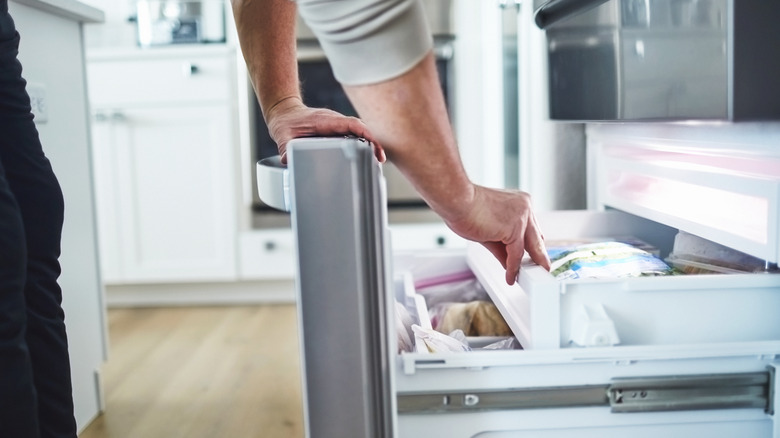The Absolute Best Way To Freeze Potato Soup For Later
Potato soup is a tasty and hearty dish but making it on your own can be labor-intensive. Accordingly, making it ahead of time and freezing it is the perfect alternative, as you can enjoy a delicious bowl when you see fit without spending lots of time in the kitchen. To ensure the reheated soup offers a pleasing flavor and consistency, you must make certain tweaks while cooking it. In this case, it's best to hold off on the dairy until you're ready to reheat it.
Ingredients like milk and cream are commonplace in potato soup, as they create the delightful consistency that makes this dish a joy to eat. However, dairy products are notorious for how poorly they freeze, as cold storage can cause the fat within dairy to separate. Keep in mind that the best silky-smooth potato soup recipe entails incorporating the cream after the potatoes, vegetables, and stock have been fully cooked. That means you can easily add cream to the finished version as you're warming it up on subsequent days.
How to prepare potato soup for freezing
After cooking your soup, give it some time to cool down before transferring it to your freezer. Placing hot food in cold storage is one of many frozen food mistakes you might be making that must be avoided. To sufficiently preserve food, the freezer must maintain a specific temperature. Adding hot items naturally raises the temperature and puts food at risk of spoilage. Freezer-safe bags are an excellent way to store your potato soup. Unlike plastic containers, bags can lay flat in your freezer to ensure you have enough room for other foods. Freezer bags also ensure that your soup is tightly sealed and protected from air exposure.
For the best results, press on the bags after filling them with soup to release air before freezing. Allowing air to linger in the bag can impact the quality of the soup, as it can contribute to the accumulation of ice crystals. When there's an excess of ice crystals in the bag, it may develop a watery texture as you reheat it. When properly stored, frozen soup can last approximately two to three months, after which the quality can degrade.
Best practices when thawing potato soup
Much like using the proper freezing techniques, it's also important that you defrost potato soup correctly. The goal is to prevent food from entering the danger zone, which according to the U.S. Department of Agriculture is 40 to 140 degrees Fahrenheit since it's the most hospitable for bacterial growth. In this case, you must stop believing defrosting myths and only use one of three recommended methods — the microwave, in the refrigerator overnight, or submerged in cold water (meaning the bag of frozen soup must be placed in cold water until it defrosts).
Along with ensuring food safety, there are steps you can take to ensure your reheated potato soup tastes amazing. For instance, adding a bit more salt can enliven the flavors, which may have become muted during the freezing process. If you don't want to incorporate more sodium, consider stirring in a small portion of vinegar or lemon juice. If you want to create some texture variations, crunchy items are key. While croutons are always a welcome addition, you can also include your favorite type of cracker or roasted nuts. With these simple tips, you can rest assured that your frozen potato soup will taste just as delicious as when it was freshly cooked.


